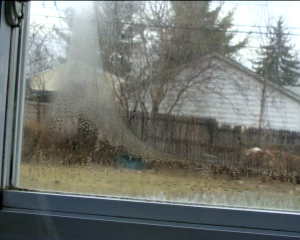 You might remember learning in science class that the three states of water are: a) liquid b) solid and c) gas. You might also recall that when water changes from liquid to gas, condensation sometimes forms. Maybe you even did a lab experiment in which you left a sealed glass container of water in the sun and watched the moisture form.
You might remember learning in science class that the three states of water are: a) liquid b) solid and c) gas. You might also recall that when water changes from liquid to gas, condensation sometimes forms. Maybe you even did a lab experiment in which you left a sealed glass container of water in the sun and watched the moisture form.
That foggy film on the lid of the glass is condensation. It’s interesting for school kids to see this in the classroom, but frustrating when it happens in your home!
Condensation is sometimes a normal and temporary occurrence and, other times, it’s a sign that you need to attend to a problem in your home or that you need to repair or replace a window.
When condensation frequently forms on one (or more) window in your home, it can be a source of irritation. After all, you have a window so that you can see out! You want to look at your yard, garden and the beautiful sky outside. You might also use your window to keep an eye on children or grandchildren playing outdoors or to make sure your home and property are safe.
Isn’t it time to stop letting that fog on your windows impede your view?
To find the right solution to your condensation problem, it’s important to understand what’s causing it.
Here are 3 common culprits…
1. Humidity
Condensation on the inside of your windows could indicate that the indoor humidity is too high. This is your cue to look around your home for the source of the problem because prolonged humidity imbalances can lead to mold, wood rot and corrosion.
High humidity inside your home could mean your bathroom or kitchen exhaust fan is not working properly. It could also be a sign that your clothes dryer is not venting effectively. Running a dehumidifier and cleaning or replacing older fans and vents are two solutions to try.
2. Fluctuating Temperatures
A quick change in the temperature outside your home can also cause window condensation. This is usually a temporary situation that happens in climates where there are noticeable temperature fluctuations as the seasons change. Opening windows (when it’s warmer) and running a dehumidifier can help your home move through the transition easily. Make sure that you open curtains and blinds so moisture doesn’t become trapped between the window covering and the glass.
3. Broken Window Seal
Chips, cracks or wear over time can break the seal between the panes of glass. Older double pane windows, usually in an aluminum or vinyl frame, have a pocket or gas between them. Because of their age and structure, they are prone to condensation. When the condensation is between the panes, it is because the seal has been compromised. Mold can actually grow between the panes if this is left untreated.
If you have a condensation problem and it’s because your window seal is broken, check to see if your windows are still under warranty with the manufacturer. If they are not, then it might be time to consider replacing the window (or windows). Be sure to choose a high quality replacement window with a life-time guarantee so that you won’t have to deal with recurring condensation again!



















You must be logged in to post a comment.